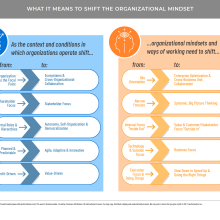This installment of StraightTalk aims to provide some context for what happens to many of us on a daily basis and why. Perhaps to help you navigate it a bit better or approach things differently – or even just to take comfort in the fact that you’re not crazy and you’re not alone. The ideas shared here are just a start and should be considered as the beginning of a conversation for us to come together around messaging and a movement that can help fuel the adoption of business architecture.
Okay, so what is The Secret?
It’s StraightTalk, so let’s get right to the point. “Business architecture” as we often talk about it, is not really about the business architecture itself.* The Secret is this: what we try to do as business architects, leaders, and change agents is actually a much bigger vision; a shift in mindset and behavior. Business architecture is simply an enabler for the bigger picture. That’s what this is all really about and that is why sometimes it is so hard.
Modeling an organization and its ecosystem is not hard. Change is hard.
At first, this might sound a little bit like blasphemy, but it’s not. The business architecture knowledgebase is still the foundation of being able to enable the type of vision and shifts we are envisioning. It’s just that we need to remember that it is really a means to an end, not an end in itself.
* Where business architecture is, according to FEAPO, “holistic, multidimensional business views of capabilities, end-to-end value delivery, information, and organizational structure; and the relationships among these business views and strategies, products, policies, initiatives, and stakeholders.” (If you’re new to business architecture, check out Post No. 1).
So, what is business architecture really about?
First, let’s give some context. The backdrop is a digital, globally connected world and the evolution of the very purpose of the firm. As a result, organizations are beginning to rethink and shift their mindsets and structures from competing as organizations to thriving as part of ecosystems, from shareholder focus to stakeholder focus, from profit-driven to value-driven, from hierarchies to self-organization, and from planned and predictable to agile and adaptive.
So, what we are really about is a new vision for strategy execution and new ways of working in our organizations and ecosystems. The amazing people who tirelessly work as business architecture practitioners, leaders and advocates were not drawn to business architecture to build a knowledgebase – but rather they were compelled by a bigger purpose and ability to make a real difference. There are many easier paths to choose from than business architecture, so we are all bonded by our vision and commitment to something greater than ourselves for the benefit of our organizations and societies.
For example, we see the need to shift organizational mindsets and ways of working…
- From silo orientation to enterprise optimization and cross-business unit (and cross-organization) collaboration
- From narrow focuses in investments and problem-solving to systemic and big picture thinking
- From an internal “inside out” focus to an “outside in” perspective which focuses on value for customers and stakeholders
- From leading with technology and solutions to thinking about the business first and what we are really trying to do
- From a focus on execution and doing things to slowing down to speed up later and make sure that we’re doing the right things
Business architecture and business architects provide the big picture (in a common language, for a broader scope of focus, and with a longer-term perspective) and bridge silos – to facilitate effective strategy execution, decision-making and design of organizations and ecosystems. Of course, there are many ways to spin the opportunity, but this seems to be coalescing as the heart of it.
See below for a handy diagram that quickly summarizes everything above.
Why is business architecture sometimes so hard for other people to grasp and see the value?
There are the basics that we all know and experience. Business architecture can seem abstract to others where business architects readily see the patterns. The word architecture makes some people think about technology or makes them feel uncomfortable because they do not understand it. There can be some history and bad associations with previous enterprise architecture efforts.
There is also the very real fact that the way we’ve socialized business architecture has sometimes been academic and we could have told the story differently. (More below on this.)
However, refer back to The Secret. This isn’t really about that capability map or those value streams. It’s hard because introducing business architecture is ultimately about introducing change.
Sometimes resistance to change just comes dressed in a different outfit. People may not come out and say, “I really don’t want to be transparent or accountable about what I’m doing, or slow down, or collaborate and pool my budget with others because it’s not what I’m used to doing or incentivized to do.” However, they may say things like “business architecture sounds like a really good thing for us to do, but I just don’t think we have the time right now.” Or, “I just don’t see the value in business architecture.”
The new vision and change we introduce pushes on just about everything: organizational structures, motivational mechanisms and even human nature. For example, if we turn to the anthropological research described in The Silo Effect1 (a must-read), we can see that a crucial part of our shared social norms and a central element of culture is the commonly held set of ideas about how we classify the world. These cultural norms are so woven into the fabric of our daily lives that we barely notice the classification system we use and just assume it to be inevitable. As humans, we have a natural tendency to sort the world into groups and silos. Our classification systems exist not just to make our internal mental processes efficient, but they are also necessary for social interaction. They are core to belonging and that goes to the heart of being human.
So while there are tremendous benefits for organizations to have a bigger picture view and bridge silos, in some respects it goes against our human nature – and that is important to keep in mind.
BTW, business architects are pretty special people who do think differently. Here’s more on how they are organizational guides and enterprise advocates and have special ways of working.
Why does all of this matter?
Let’s return to Simon Sinek and the golden circle of Why? How? What? that explains why some organizations and some leaders are able to inspire and succeed where others are not.
Sinek states that the way we typically communicate is to first say what we do, then say how we are different or better than others – and then we expect some sort of action from others such as a behavior, a purchase, a vote, etc.
However, the golden circle starts with why. Sinek references Apple’s success by doing this. For example:
- First comes the why: “Everything we do, we believe in challenging the status quo. We believe in thinking differently.”
- Then comes the how: “The way we challenge the status quo is by making our products beautifully designed, simple to use and user-friendly.”
- And then finally comes the what: “We just happen to make great computers. Want to buy one?”2
So why all of this matters is that for us to be successful, we need to tell our story in the right way. We need to start with why. Socializing business architecture as a discipline won’t get us to where we want to go because business architecture is the what. It’s a means to the end.
This all starts with being clear and honest with ourselves about what we’re really trying to do and painting the picture of that vision (the why) for others along with the better results they will achieve. This will open the door for business architecture to be at the heart of that solution, which of course must include a partnership with many other teams as well.
If people can’t see and feel a compelling vision, they are certainly not going to be motivated to care or change.
So where do we go from here?
This is a call to action. It’s a call for bold leadership, vision and collaboration.
We believe in the discipline of business architecture and the important benefits that it provides, so let’s articulate our why with clarity and rally around it.
Let’s start a movement for the benefit of our organizations and world.
More Good Stuff…
How Great Leaders Inspire Action (TED Talk): A classic must-watch TED Talk by Simon Sinek on the golden circle of Why, How, What. It provides a framework upon which organizations can be built, movements can be led, and people can be inspired. And it all starts with Why. If you haven’t seen it, watch it now. If you have seen it, watch it again.
Start with Why: How Great Leaders Inspire Everyone to Take Action (Simon Sinek): A book by Simon Sinek on the same important topic.
How to Start a Movement (TED Talk): Speaking of movements, in less than 3 minutes, here’s how to start one. Fun + serious wisdom here.
The Silo Effect: The Peril of Expertise and the Promise of Breaking Down Barriers (Gillian Tett): This book applies an anthropologist’s lens to the problem of why so many organizations still suffer from a failure to communicate. It shares tales of the silo syndrome, yes, but also shows how institutions and individuals can master their silos instead. This one is a must-read!
Breaking Down the Silos (Psychology Today): Reflections on what it takes for smart collaboration.
Smart Collaboration: How Professionals and Their Firms Succeed by Breaking Down Silos (Heidi K. Gardner): This book offers powerful prescriptions for how leaders can foster collaboration, move to higher-margin work, increase client satisfaction, improve lateral hiring, decrease enterprise risk, engage workers to contribute their utmost, break down silos, and boost their bottom line.
94 Mind-Blowing Strategy Execution Stats (Boardview): A gold mine of statistics on strategy execution all in one place. These are really helpful when you’re making a case for business architecture.
The Strategy Execution Metanoia: A New Approach for Translating Strategy Into Action with Business Architecture (S2E Whitepaper): A foundational whitepaper that explores how business architecture can be leveraged as a means to an integrated business direction that is collectively architected, prioritized and planned from a business-driven, enterprise-wide perspective.
The Future of Management Is Teal (Strategy+Business): An outstanding article on how organizations are moving forward along an evolutionary spectrum, toward self-management, wholeness, and a deeper sense of purpose. Also check out the book on Reinventing Organizations: A Guide to Creating Organizations Inspired by the Next Stage of Human Consciousness.

